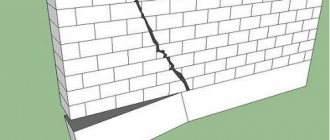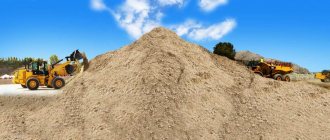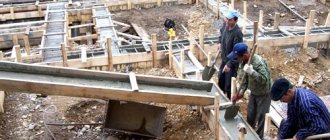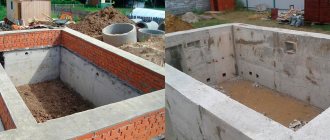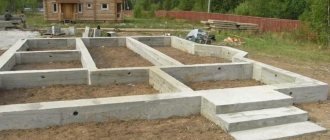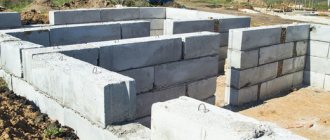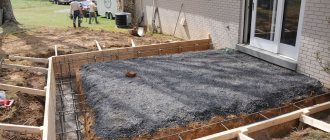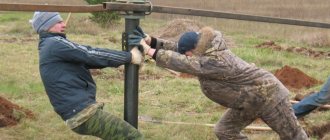Why is sand poured into the base of the foundation? Is such a pillow necessary at all? What material is best to use for this purpose? We will try to answer all questions. You will receive information about the role of sand under the foundation of a house and the criteria for its selection.
From the Soil Trucks company you can buy sand for foundation cushions with delivery to your site.
Price for Sand for foundation cushion from RUB 1,270.
for 1m3 Order So, sand performs several functions:
- Levels the surface of the trench.
- Evenly distributes the load from the upper layers and prevents subsidence of the building.
- Partially replaces problematic soil (clayey, peat, organic-rich chernozem).
- It is one of the components of the drainage system under the building.
Which sand is best for foundation cushion?
Sand is a high-density bulk material and is successfully used both in construction and for the construction of wastewater treatment plants.
Creating a sand cushion is one of the important stages of construction. Unfortunately, not all experts will be able to answer the question about the need to place it under the foundation and what sand should be used.
When the question arises of what kind of sand is needed for a cushion under the foundation, it is first of all necessary to understand what functions this embankment performs.
The alignment function is relevant in situations that can be called ideal. The soil is homogeneous, motionless and does not contain impurities of organic soil or clay. Consequently, the job of sand is limited to leveling the trench bottom or the bottom of a pit.
In cases where organomineral soil (peat) is located under future construction, you can be sure of the mobility of the soil and a decrease in its bearing capacity. To avoid destruction of structures, it is necessary to remove a large amount of soil until the organic layer is exhausted. The greater depth created after the excavation of organic soil is filled with sand.
Compensating for deformation is the main task of sand when performing the third functional purpose. Clay and other heaving soils, being under the support of a house, significantly affect the distribution of loads. Which, as is known, can lead to the complete destruction of slabs or concrete strips.
How it works.
The thickness of the cushion that performs leveling functions, as a rule, does not exceed 200mm. Sand is poured once onto the bottom of the trench and leveled. Then it is slightly moistened and carefully compacted. All other varieties of this necessary element directly depend on the size of the foundation base. They are calculated individually in each case.
Selection of material.
What sand to use for foundation cushion? Unfortunately, few people think about this issue. Construction continues with the material that will be delivered to the site. But the basic properties of the building material itself greatly influence the strength of the structure.
It is necessary to note what kind of sand should not be used for the foundation cushion:
- With small grains. The higher the particle size modulus, the better and better the quality of the embankment for the foundation. The pillow will be easier to compact and be affected by humidity.
- Dirty. The presence of large stones or particles of organic soil in the bulk material radically changes the physical properties of the pillow. Clay particles are especially dangerous. The presence of its impurities in sand contributes to greater soil mobility and a decrease in its bearing capacity. Clay retains moisture, which will negatively affect the sand bed.
- The sand used for the cushion under the foundation must be washed. It is best to use river sand or quarry sand. Also, the optimal solution would be to use gravel material.
The use of river sand significantly increases the cost of construction work. Quarry sand, thoroughly washed with a huge amount of water to remove clay and silt impurities, will cost an order of magnitude cheaper.
The pillow under the foundation has a difficult task - the correct distribution of the load, so you should not save much on the material on which further construction work depends.
What kind of sand is needed for a foundation cushion: the right choice.
What kind of sand is needed to cushion a strip foundation.
A solid foundation for the house will allow the structure to stand for decades. The construction of a home begins with laying the foundation, and the choice of materials for it should be approached responsibly and competently.
Reliable support for a building requires not only high-quality concrete and reinforcement, but also proper filling of the pit. What kind of sand is needed for the foundation cushion should be chosen before starting work.
Concrete base
The most expensive and reliable type of underlying layer. A concrete pad can even be used for the foundations of apartment buildings. The technology for its implementation is quite simple and accessible for independent work. The process consists of several stages:
- leveling the bottom of the excavation;
- adding crushed stone with a layer of 10 cm and tamping;
- installation of formwork to the height according to the project;
- waterproofing flooring;
- installation of reinforcement;
- pouring concrete mortar;
- gaining monolith design strength;
- dismantling formwork.
To ensure strong adhesion of the base to the foundation, steel rods protruding above the surface are installed in the cushion. They serve as connecting anchors, maximizing the strength of the underground structure.
Why is a sand cushion poured?
A capital structure must have a solid foundation. It is provided by a monolithic foundation on a special pillow. After digging a pit to a depth that allows the soil to avoid freezing in winter, sand is poured into the bottom of the hole.
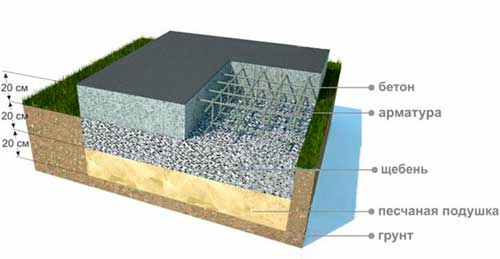
What kind of sand is needed for the foundation.
This bedding is recommended in several cases:
- When installing a house on empty ground. The sand layer replaces the excavated soil, which avoids deformation after freezing and thawing cycles;
- The horizontal level is important during construction; an embankment of sedimentary rock helps to ensure it; it conceals all unevenness, is easily distributed and levels the construction site;
- The layer will serve as an additional barrier protecting against dampness and groundwater;
- The embankment will reduce the settlement of the building, the material perfectly resists compression forces, while its costs are minimal;
- When constructing a building with several floors, the cushion serves for shock absorption.
Needed or not?
According to SP 22.13330.2016 (SNiP 2.02.01-83*), before laying a monolithic foundation slab for a structure, it is necessary to install a special cushion.
Its role is as follows:
- forms a smooth and high-quality bottom of the base;
- is responsible for the uniform distribution of pressure on the ground due to resistance to soil compression;
- resists freezing of the foundation in winter;
- ensures the stability of the structure during operation;
- minimizes possible shrinkage of the structure;
- is an insulating layer from soil moisture entering the foundation of the house.
Based on the above aspects, the installation of a damper substrate is a necessary stage in the construction of a slab foundation. Otherwise, the risk of premature deformation and destruction of the entire structure due to soil freezing remains.
What kind of sand is best to pour under the base?
To lay the bottom of a pit, you should not take the first sand you come across; there are rules and regulations for its selection. Three types of sedimentary rock are sold on the construction market.
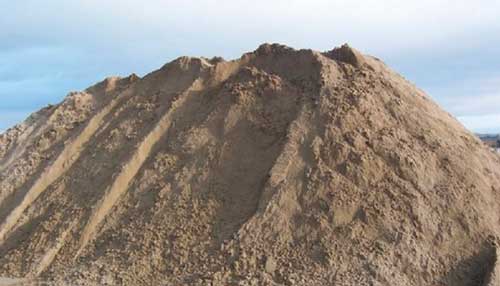
What kind of sand is needed for the foundation cushion.
Quarry - has low quality due to the large volume of impurities of clay and other substances. Its popularity is due to its low cost. Developers often use quarry sand in zero cycles, which is quite acceptable, but it is worth monitoring the quality.
Marine - its development is carried out from the bottom of the sea, so the sedimentary rock contains a lot of shells and impurities. Manufacturers perform mandatory cleaning of their product. It is also suitable for creating a pillow.

What kind of sand is needed for the foundation cushion.
River sand is a universal type of sand used at all stages of construction. Due to natural grinding, it obtains the ideal particle shape, allowing you to make a reliable solution. The material is characterized by the absence of clay and organic compounds.
This type is the best option for a pillow under the foundation. The high cost of the material forces budget-conscious builders to abandon it in favor of a lower quality, but more affordable one.
The material extracted from the bottom of rivers is not uniform. When choosing what kind of sand is needed for a special cushion for a reliable foundation, it is worth understanding the size of the rock.
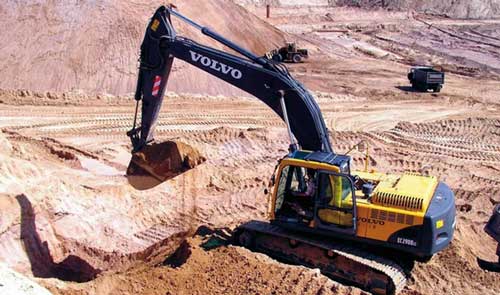
What kind of sand is needed for a pillow under the foundation.
There are several fractions of the material, their sizes range from 0.7 mm to more than 3.5 mm. The small size of sand grains is not suitable for adding to the foundation pit; it shrinks and compacts very tightly. Sand with this fraction can only be used for light outbuildings.
Residential one-story buildings are built on an embankment of medium or large sand of 2 to 3 mm. The construction of multi-storey structures requires extremely coarse material. As the size of the sand grains increases, the value of the sediment also increases.
Requirements for the quality of the material and the thickness of the pillow.
In addition to particle size, important requirements for material quality are:
- The absence of clay, which retains moisture and makes the bedding layer mobile;
- Cleanliness of the mixture - removal of branches or other foreign objects;
- Sand moisture – excessive or insufficient amount of water negatively affects the properties of the material;
- The presence of gravel in the composition improves the characteristics of the embankment.
The layer of sedimentary rock is the first thing that is poured into the hole dug for the foundation. It is determined by the composition of the soil and the purposes for which it is intended.
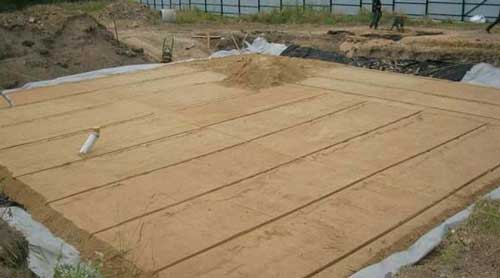
What kind of sand is needed for a pillow under the foundation.
A small embankment for leveling the site is 10 cm, the depth of the layer in case of heaving soil should reach 20 cm. In any case, the size of the embankment should not exceed 1/3 of the width of the foundation.
Important! Before pouring sand into the pit, it is better to sift it to avoid unnecessary inclusions.
How to properly lay the foundation for pouring the foundation?
Initially, the perimeter of the future walls is marked at the construction site and a trench is dug. Depending on the depth and width of the pit, they work with a shovel or order an excavator.
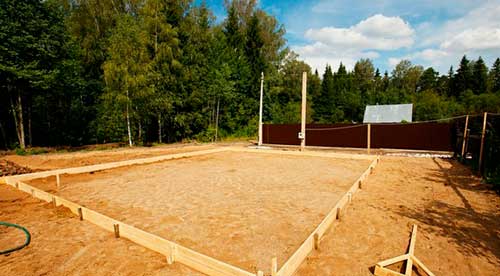
What kind of sand is needed for the foundation.
We figured out what kind of sand is needed for the cushion under the foundation, now we need to figure out how it is laid and compacted. It is necessary to lay a geotextile sheet under the layer of sand. This will create additional drainage and protect the embankment from silting and mixing with the soil.
The poured material needs to be moistened for better compaction. It is filled in parts, each of which is compacted tightly with a homemade timber tamper with handles or a special tool - a vibrator.

Important! It is impossible to properly compact 20 cm of sedimentary rock poured at the same time, so sand is added gradually. Compaction should reach the point where footprints no longer remain on the surface.
The quality of the compaction determines whether the building will subsequently sag. We must not forget about the horizontality of the sand embankment.
About the preparatory work for the foundation in the video:
A framework of reinforcement is laid on the finished pillow - metal rods are tied together with wire. Removable formwork from boards is installed and concrete is poured. A reliable and high-quality foundation will allow the building to stand for a long time without shrinkage or damage to the foundation.
Useful functions of geotextiles

Strengthening load-bearing capacity. When a foundation is laid on heaving soils, there is a risk of its excessive shrinkage and even failure. In such a situation, the soil needs to be strengthened. There are different methods, but the simplest is laying a geogrid. To do this, material is placed in the pit, on which crushed stone is laid out and on top of it, the material is again placed. The elasticity of the geogrid is very high. It allows you to evenly distribute the load in the pillow. In addition, separation occurs between the layers of sand and crushed stone.
About the choice of geotextiles : its density is determined in each specific case and depends on the soil. The main indicator is the pressure applied. Therefore, the best solution is to consult a specialist.
I will add that the material reduces the seepage of water located under the sand and tending to the foundation. Effective in arranging drainage, actively preventing siltation, etc. In general, useful and quite worthwhile material. By the way, numerous reviews and recommendations of construction professionals speak about this.
I'm glad if my information was interesting and understandable. Thank you for your time and I invite you to subscribe to updates on this blog. If you find the article useful, recommend it to your friends online. See you soon!
Wisdom Quote: What interests everyone interests no one.
How is a sand cushion created for a strip foundation?
The foundation cushion is a layer of a certain material (crushed stone, sand, gravel, concrete) laid under the base. Its main purpose is to give the future foundation of the house stability and a stable location with subsequent minimal shrinkage. The choice of a specific type of pillow is made based on the location of groundwater, type of soil, number of storeys of the building, climatic conditions of the area, materials used to build the house.
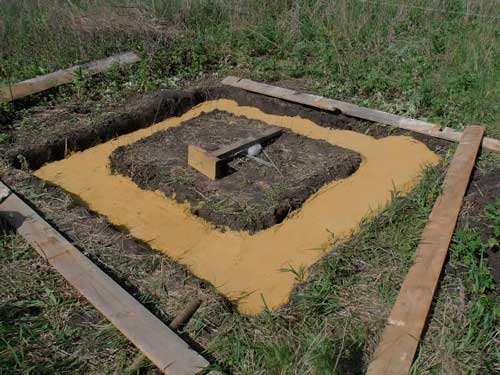
What kind of sand is needed to cushion a strip foundation.
The advantages of a sand cushion: low cost and ease of construction; the main disadvantage is the inability to erect heavy buildings on it.
A sand cushion for the foundation is the most acceptable option for those who want to save significantly on construction work. Sand best softens the load on the foundation of a building. The laid layer of material is an intermediate link between the soil and the foundation of the house, which prevents the harmful effects of moisture on the foundation.
What kind of sand is needed for the foundation of a house.
Strip foundation on a sand cushion.
In addition, the advantages of using a sand cushion under the foundation are:
- availability of material (there are sand deposits in every region);
- low thermal conductivity (large losses of thermal energy are prevented);
- suitability for dense compaction;
- ease of creation.
Perhaps the only drawback of a sand bed is the impossibility of building multi-story and heavy buildings on it.
It is most advisable to construct a sand cushion in the following cases:
- location of groundwater at a decent distance from the surface;
- construction of houses from light materials (foam blocks and frame structures);
- construction of a one-story building.
Conditions under which bedding is required
The presence of a cushion is mandatory when creating a shallow strip foundation. The layers of soil located under the tape create loads that push the base out of the trench . The pillow takes on these efforts and compensates them to a large extent.
An additional condition for the presence of a cushion is the possibility of groundwater or rainwater entering the trench. The backfill layer helps accumulate runoff at the bottom of the trench, where moisture enters the drainage pipes and is discharged into special wells or reservoirs.
It must be taken into account that a sand cushion of at least minimal thickness is present in any case.
It levels the bottom of the trench, allowing you to obtain a horizontal and even plane without the use of complex and time-consuming technological techniques.
